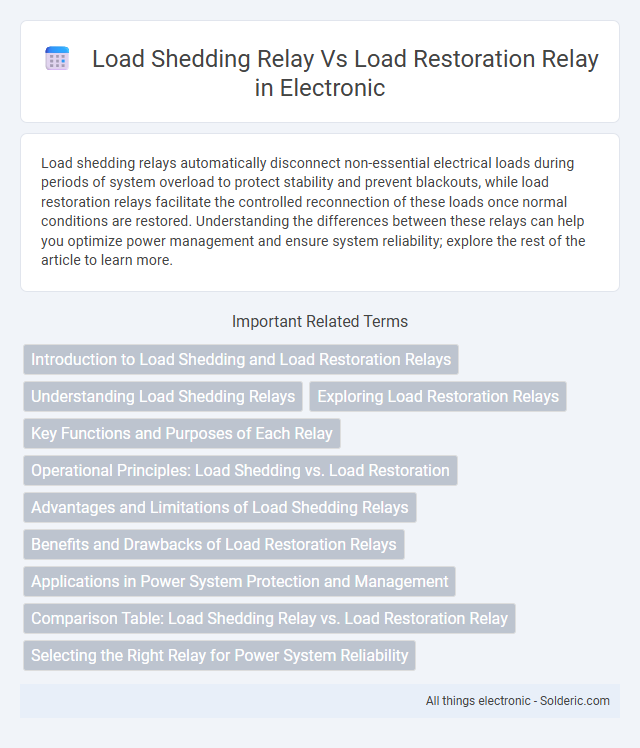Load shedding relays automatically disconnect non-essential electrical loads during periods of system overload to protect stability and prevent blackouts, while load restoration relays facilitate the controlled reconnection of these loads once normal conditions are restored. Understanding the differences between these relays can help you optimize power management and ensure system reliability; explore the rest of the article to learn more.
Comparison Table
| Feature | Load Shedding Relay | Load Restoration Relay |
|---|---|---|
| Purpose | Automatically disconnects loads to prevent system overload | Reconnects loads after system stability is restored |
| Function | Reduces power demand during faults or low generation | Restores loads in a controlled manner post-fault or power restoration |
| Activation Criteria | Frequency drop, voltage drop, or system overload | Stable voltage and frequency after fault clearance |
| Control Type | Protective, preventive action | Restorative, system recovery action |
| Application | Power systems during generation shortage or grid instability | Power systems to resume normal load after disturbance |
| Impact on System | Reduces load to maintain system stability | Gradually restores load to avoid system stress |
Introduction to Load Shedding and Load Restoration Relays
Load shedding relays are critical devices designed to prevent system overloads by disconnecting non-essential loads during peak demand or fault conditions. Load restoration relays gradually reconnect these loads once normal conditions are restored, ensuring system stability and preventing sudden surges. Understanding your power system's load shedding and load restoration relays enhances reliability and minimizes outage impact.
Understanding Load Shedding Relays
Load shedding relays automatically disconnect electrical loads to prevent system overload and maintain grid stability during peak demand or faults. These relays monitor system parameters such as frequency and voltage to initiate staged load reduction, protecting critical infrastructure from blackouts. Load restoration relays, by contrast, focus on gradually reconnecting loads once normal operating conditions are restored, ensuring a balanced and reliable power recovery process.
Exploring Load Restoration Relays
Load restoration relays play a crucial role in power system recovery by automatically re-energizing feeders and loads after a load shedding event, ensuring system stability and minimizing downtime. Unlike load shedding relays that initiate disconnection to prevent system overloads, load restoration relays coordinate the gradual reconnection of loads based on system parameters such as voltage, frequency, and breaker status. This controlled restoration process optimizes grid reliability and helps maintain balanced power distribution during post-disturbance recovery.
Key Functions and Purposes of Each Relay
Load shedding relays are designed to disconnect non-essential electrical loads during peak demand or fault conditions to prevent system collapse and maintain grid stability. Load restoration relays function by sequentially reconnecting loads once system conditions normalize, ensuring a controlled and safe return to normal operation. Both relays play critical roles in power system protection and load management to optimize reliability and prevent blackouts.
Operational Principles: Load Shedding vs. Load Restoration
Load shedding relays operate by detecting overload conditions or fault signals to automatically disconnect selected loads, reducing demand on the power system and preventing outages. Load restoration relays function to sequentially reconnect loads based on priority and system stability criteria once normal conditions are restored, ensuring balanced recovery without causing overloads. Both relays rely on real-time monitoring of system parameters such as voltage, frequency, and current to optimize power management during disturbances.
Advantages and Limitations of Load Shedding Relays
Load shedding relays provide the advantage of preventing system overload by selectively disconnecting non-critical loads, enhancing grid stability and protecting equipment. They have limitations such as potential disruption to consumers and inability to restore power automatically after an outage. Your system benefits from these relays through improved fault management, but may require complementary load restoration relays for re-energizing the disconnected loads.
Benefits and Drawbacks of Load Restoration Relays
Load restoration relays enable automatic reconnection of power loads after outages, improving system reliability and reducing downtime by minimizing manual intervention. However, they may introduce complexity in protection schemes and risk load reconnection during unstable system conditions, potentially causing equipment damage. Proper coordination and settings are crucial to maximize benefits while mitigating operational risks associated with load restoration relays.
Applications in Power System Protection and Management
Load shedding relays are crucial for preventing system collapse by disconnecting non-essential loads when power generation is insufficient, ensuring the stability of the grid during faults or peak demand. Load restoration relays facilitate the controlled reconnection of loads after an outage or system imbalance, optimizing recovery and minimizing the risk of overloading the network. Your power system's protection and management benefit from the coordinated operation of both relay types to maintain reliability and operational continuity.
Comparison Table: Load Shedding Relay vs. Load Restoration Relay
The comparison table highlights critical differences between load shedding relays and load restoration relays, focusing on their primary functions, application scenarios, and operational criteria. Load shedding relays are designed to disconnect non-essential loads during power shortages to prevent system overload, while load restoration relays facilitate the sequential reconnection of loads after power recovery, ensuring system stability. Understanding these distinctions helps you optimize power system management by selecting the appropriate relay type for emergency control and post-fault recovery.
Selecting the Right Relay for Power System Reliability
Selecting the right relay for power system reliability involves understanding the distinct roles of load shedding and load restoration relays. Load shedding relays protect the system by prioritizing critical loads during faults or overloads to prevent blackouts, while load restoration relays help re-energize and balance the network after disturbances, ensuring quick recovery and stability. Your power system's reliability depends on accurately choosing and coordinating these relays to maintain continuous operation and avoid prolonged outages.
load shedding relay vs load restoration relay Infographic

 solderic.com
solderic.com